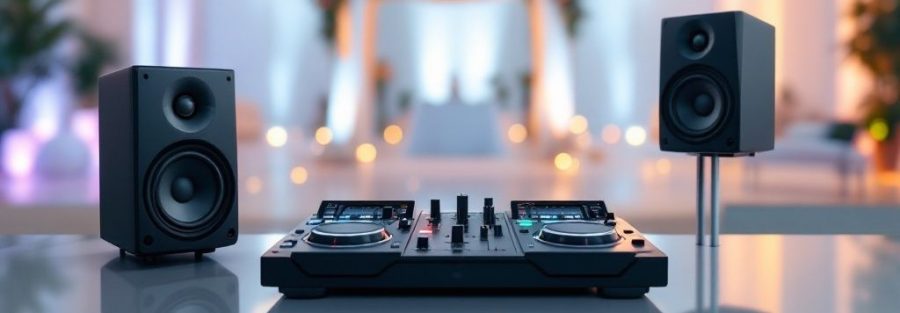Putting together your first DJ sound solution can feel a bit daunting, but it really just comes down to a few key pieces of gear working in sync. I like to think of the mixer as the brain, the controller as your hands, and the speakers as the voice of the whole operation. Nail these three things, and you've built a solid foundation for delivering incredible sound at any event.
Building Your First DJ Sound System
Jumping into the world of DJ equipment can make your head spin, especially since new tech is dropping all the time. The global DJ gear market was valued at a whopping USD 1.5 billion in 2023 and is only getting bigger, which tells you just how much innovation is happening. But don't get bogged down by the sheer number of options; building a killer starter rig is way easier than it looks.
The main goal here is to create a system where every piece of equipment plays well with the others. That synergy is what delivers that clean, powerful sound and separates a truly professional setup from a cobbled-together amateur one.
The Essential Trio: Speakers, Mixers, and Controllers
At its heart, any DJ setup has three pieces you simply can't do without. These are the cornerstones of your rig, whether you're spinning tunes at a backyard party or a high-end wedding.
- Speakers and Subwoofers: This is how your audience hears the music. Your main speakers will handle the mid and high-range frequencies—think vocals and melodies—while the subwoofers bring the thunder with that deep, punchy bass that you can feel in your chest.
- DJ Mixer: This is your command center. The mixer is where all the magic happens, letting you blend tracks together, control the volume, tweak the EQ, and add effects.
- Controller or Turntables: These are your instruments. They give you that hands-on, tactile control over your music software, so you can cue up the next song, scratch, and mix with real precision.
This handy diagram breaks down how these core components fit together in most DJ sound setups.
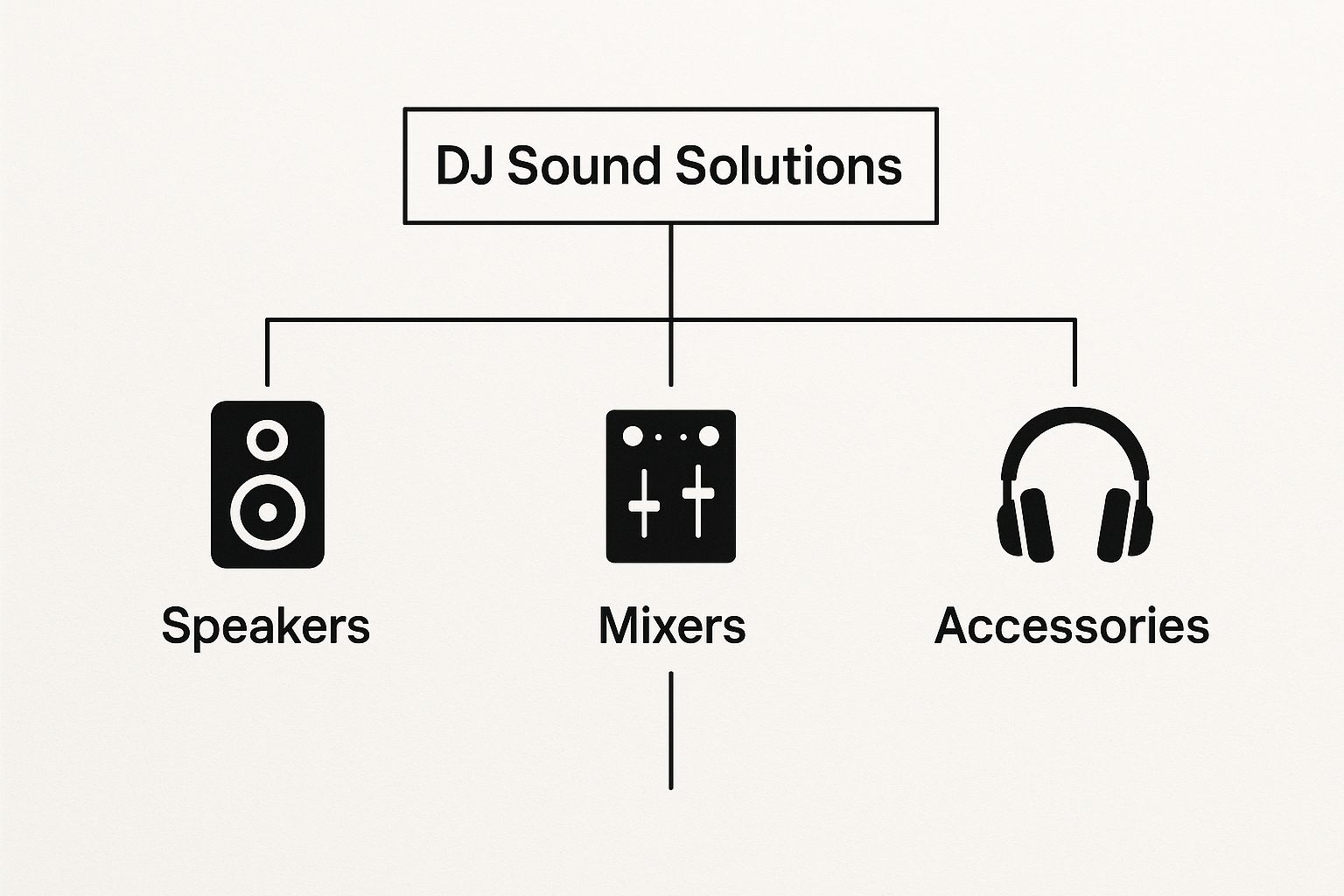
As you can see, speakers, mixers, and all the accessories around them create the fundamental building blocks of any rig. Getting comfortable with these pieces is your first big step.
To make it even clearer, here’s a quick rundown of what each core component does and what to look for.
Table: Core Components of a DJ Sound Solution
| Component | Primary Function | Key Consideration |
|---|---|---|
| Speakers | Projects the final audio to the audience. | Active (built-in amp) vs. Passive (needs external amp). |
| Subwoofer | Reproduces low-frequency bass sounds. | Size and power (watts) determine the bass impact. |
| DJ Mixer | Blends and manipulates audio from multiple sources. | Number of channels (2 vs. 4) and built-in effects. |
| Controller | Provides hands-on control of DJ software. | All-in-one unit vs. modular setup with turntables. |
| Headphones | Allows you to privately cue up the next track. | Noise isolation and durability are crucial. |
Getting these essentials right is the key to a setup that not only works but sounds fantastic.
What to Prioritize as a Beginner
When you're just starting out, my advice is always the same: focus on quality, not quantity. You're far better off investing in a solid pair of active speakers and a simple, reliable 2-channel mixer than getting overwhelmed by a complex system you don't know how to use yet. You can always add more gear to your collection as you get more gigs and your skills develop.
A great sound system doesn't just play music; it's the bridge between your creative vision and the audience's experience. The right equipment lets you craft a vibe that people will remember long after the night is over.
For certain gigs, like weddings, getting the audio right is absolutely crucial. To see what a professional setup for such an important day looks like, check out our guide on wedding sound system rental options. It'll give you a great idea of what it takes to make sure every speech and special song is heard perfectly.
Choosing Speakers for Any Venue
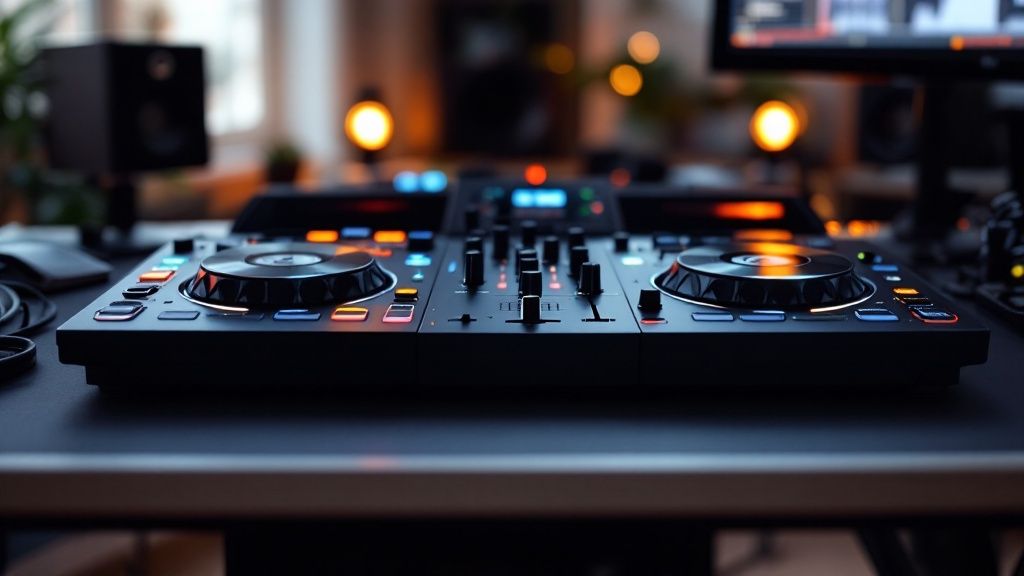
Your speakers are the voice of your entire performance. Seriously. Getting this part wrong can tank an otherwise killer set.
Think of it this way: you wouldn't try to power a semi-truck with a Smart car engine. By the same token, the speakers that sound great in a small lounge will be completely swallowed up by the noise and space of a big wedding hall. The whole game is about matching the right gear to the room you're in.
Active vs. Passive Speakers
The first fork in the road is choosing between active (or powered) speakers and passive ones. For any DJ who isn't permanently installed at a club, this is an easy decision.
- Active (Powered) Speakers are the all-in-one solution. They have the amplifier built right in, which means fewer cables to trip over, a much faster setup time, and less gear to lug around. They're designed for a grab-and-go world.
- Passive Speakers are just the speaker cone in a box. They need a separate, external amplifier to make any noise. While this offers some flexibility for a permanent club sound system, it's an extra layer of complexity and weight most mobile DJs just don't need.
For DJs on the move, active speakers are the clear winner. It's not even a debate.
Matching Power to the People
Okay, so you're going with active speakers. Now, how much power do you actually need? We're talking about watts, and it's not just about being loud. The goal is to fill the space with clean, rich sound that doesn't distort or make people's ears bleed.
A good starting point is to budget about 5-10 watts per person for an indoor gig. But that's just a guideline.
- Small, Intimate Venues (50-100 guests): For a cozy wedding reception or a private birthday bash, a pair of 12-inch active speakers pushing around 1,000 watts (peak power) each will do the job beautifully.
- Medium to Large Venues (100-250+ guests): When you're playing for bigger crowds in spacious ballrooms or corporate event halls, you need to bring more firepower. Here, a setup with two 15-inch mains and at least one subwoofer isn't just an upgrade; it's essential for making the music feel full and present.
Here's a pro tip: It's always better to have more power than you need and keep the volume knob down than to crank a small system to its breaking point. An overworked, underpowered system just sounds awful—it gets distorted, thin, and wears out your audience's ears fast.
The Secret Weapon: Subwoofers
Your main speakers (your "tops") are great for handling the vocals, synths, and high-hats—all the mid and high-range frequencies. But the subwoofer is your secret weapon for a truly memorable night.
Subs are built for one thing and one thing only: reproducing those deep, low-end frequencies. We're talking about the bass you feel in your chest, the thump that physically moves people and gets them onto the dance floor.
Without a subwoofer, even the best DJ sound solutions can sound disappointingly thin and anemic, especially in bigger rooms where bass just seems to vanish. If people are there to dance, a sub isn't optional. It's mandatory.
Getting the audio right involves balancing crystal-clear sound for speeches with that powerful punch for the party. To dive deeper into creating that perfect balance, check out our complete guide on the ideal sound for a wedding.
Why the DJ Mixer Is Your Creative Hub
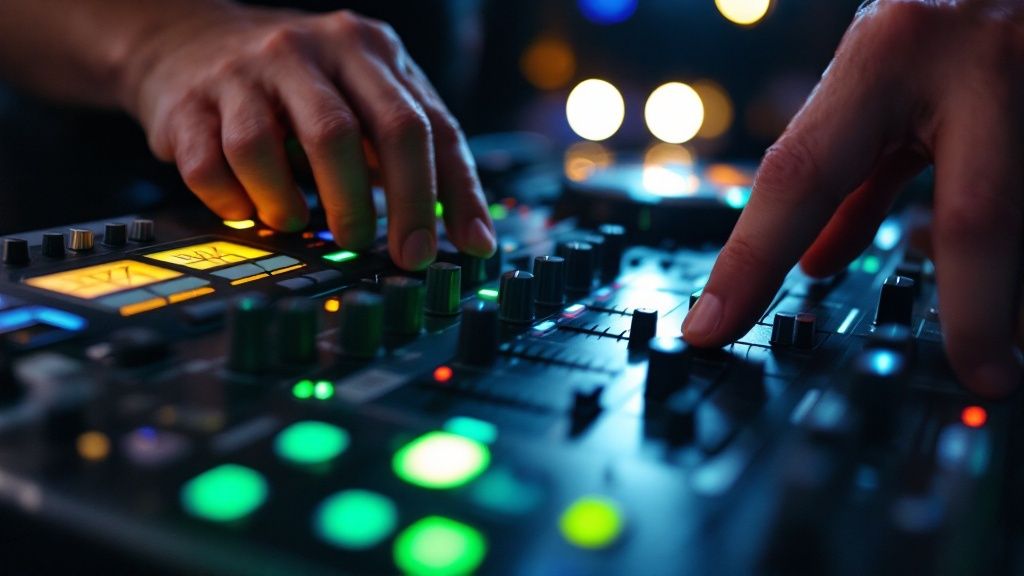
If your speakers are the voice of your DJ setup, the mixer is the brain. Simple as that. It’s way more than just a box with a few volume faders; it's the command center where you take individual tracks and weave them into a seamless experience for the crowd. Every sound, whether from a turntable, controller, or laptop, passes through this single piece of gear.
This is where the magic really happens. The mixer is how you gracefully move from a chill dinner vibe into a high-octane dance set without missing a beat. Get this part wrong, and even the best DJ sound solutions will sound disjointed and clunky.
Channels Your Creative Flow
One of the first decisions you'll face is whether to go with a 2-channel or a 4-channel mixer. Think of each channel as its own separate lane for audio that you can control.
- 2-Channel Mixers: This is the classic setup and the perfect place to start. Two channels let you mix between two sound sources, like a pair of turntables or two decks on a controller. They're straightforward, less cluttered, and fantastic for mastering the fundamentals of blending.
- 4-Channel Mixers: Ready to get more complex? A 4-channel mixer opens up a whole new world. You can mix with four decks at once, or plug in other toys like a sampler or a microphone. It just gives you way more room to play and experiment.
Honestly, for most mobile DJs rocking weddings and private parties, a solid 2-channel mixer is all you'll ever need. But as you get more ambitious, upgrading to four channels can completely change your game.
Sculpting Sound with EQs and Effects
A mixer isn't just for fading between songs—it’s your main tool for shaping the sound itself. Those EQ knobs for bass, mids, and treble on each channel? They're your best friends. Skillfully rolling off the bass on the track that’s ending as you bring in the next one is the secret to those buttery-smooth transitions that sound like they were made in a studio.
A great DJ doesn't just play songs; they conduct the energy of the room. The mixer is their baton, allowing them to fine-tune the emotional arc of the night, one beat at a time.
Plus, most mixers today have built-in effects like echo, reverb, and filters. These are your tools for adding a little drama, creating massive build-ups, and stamping your personal style on the music. Learning to use them with a bit of taste is what separates the pros from the rookies. To see how all this gear fits into the bigger picture, check out our guide on the perfect wedding DJ setup.
The demand for this kind of creative control is exploding. The global market for DJ hardware and software hit USD 2.5 billion in 2023 and is projected to more than double by 2033. It's all driven by DJs wanting more power at their fingertips. You can read more on this market growth to get a sense of where the industry is headed.
Integrating Modern DJ Software and Tools
https://www.youtube.com/embed/Lj4XH3v9nOc
Not too long ago, you could practically measure a DJ's experience by the sheer weight of their record crates. Today, the most powerful tool in the booth is usually a laptop, the digital heart of any modern dj sound solution. Software has completely flipped the script on how we organize, mix, and perform.
Think of programs like Serato, Rekordbox, and Traktor as your mission control. Instead of digging through crates, you’ve got thousands of tracks perfectly organized and just a click away. These platforms do more than just hold your music—they analyze it, giving you crucial data like the song's key and beats per minute (BPM). This is what makes those silky smooth, harmonically-matched transitions possible, a feat that used to be incredibly tough to nail live.
Bridging the Digital and Physical Worlds
But let's be real, nobody wants to watch a DJ stare at a laptop all night. That's where DJ controllers save the day. A controller is the physical link between you and your software, giving you a hands-on, tactile way to command your digital library.
Every spin of a jog wheel, push of a fader, or tap on a performance pad gets instantly translated into an action inside the software. It’s the perfect marriage, giving you the massive power of digital music management with the classic, hands-on feel of traditional DJing. This dynamic duo is the secret sauce to a flawless, professional performance.
DJ software doesn't just replace record crates; it unlocks a whole new level of creativity. From live remixing with sample pads to syncing tracks perfectly with a single button, these tools empower you to craft a set that is uniquely yours.
The explosion in this space is impossible to ignore. The DJ software market was already valued at USD 0.44 billion back in 2022 and is expected to hit USD 0.7 billion by 2032. This just shows how much the industry has embraced digital tools that make a DJ's life easier and open up new creative doors. You can discover more insights about the DJ software market to see where the tech is headed.
Beyond the Music
Modern software and controllers aren't just for mixing audio anymore. Many now integrate directly with lighting and visual systems, letting you create a full-blown sensory experience. When the atmosphere is everything, syncing your sound with stunning visuals can leave a massive impression. For more ideas on building a complete event vibe, check out our guide on combining a photo booth and DJ service.
How to Adapt Your Sound Setup for Any Event
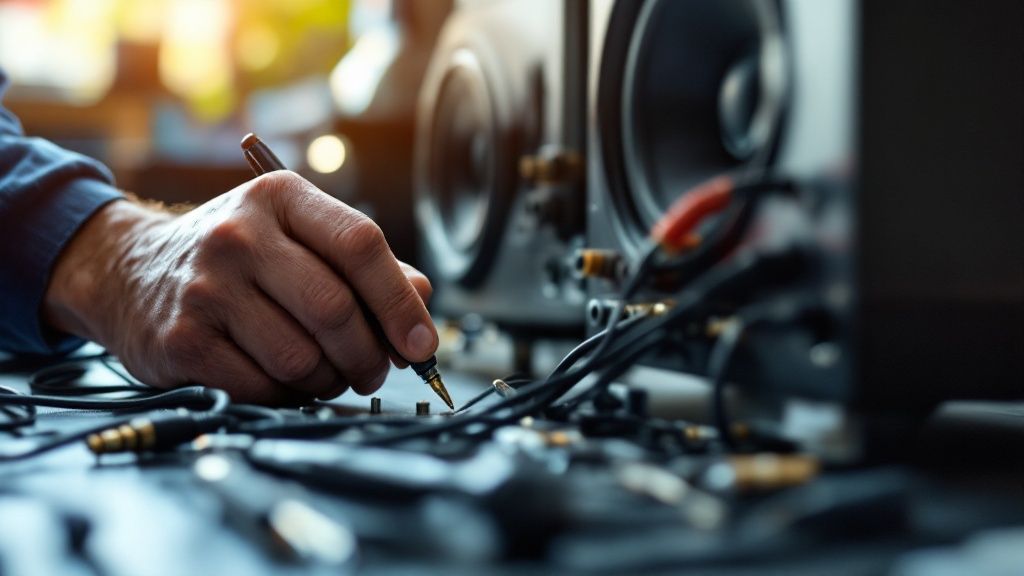
Ask any seasoned DJ, and they’ll tell you that no two gigs are the same. Each event has its own personality, its own sonic fingerprint. The bass-heavy system you bring to a high-energy birthday bash would feel completely wrong at an elegant corporate mixer. This is where the real art comes in—learning to tailor your DJ sound solutions to perfectly match the venue and the vibe.
This isn't just about playing the right music; it’s about crafting the entire audio experience. From making sure wedding vows are heard crystal-clear to providing a subtle background track for a networking event, your sound system is the invisible architecture holding the whole thing together. It’s what separates the pros from the amateurs.
The Wedding Blueprint: Versatility Is Key
Weddings are the ultimate test of your adaptability. You're not just DJing one party; you're often the sound technician for two or three completely different events packed into a single day.
-
Ceremony Sound: For the ceremony, it's all about clarity and discretion. Think a clean speaker setup and, crucially, top-notch wireless microphones. You'll want a handheld for any readers and lavalier (lapel) mics for the officiant and the couple. The mission is simple: every single guest needs to hear the vows without tripping over a single cable.
-
Reception Dynamics: Then, it’s time to party. The needs flip entirely. This is where you bring in a more powerful system with subwoofers to get that dance floor thumping. I often think in terms of "sound zones"—the dance floor should be loud and immersive, but guests at their tables should still be able to hold a conversation without shouting.
A wedding sound system has to do two things perfectly: deliver every spoken word with absolute clarity and make people want to dance all night. Mastering both is the hallmark of a true professional.
The Corporate Event: Focus on Professionalism
Corporate gigs are a different animal. While music plays a role, the number one priority is almost always flawless communication. Your sound setup has to reflect that with polished, professional audio from the moment the first guest arrives.
Pristine vocal reproduction is the name of the game. That means investing in high-quality wireless mics for speakers and making sure your system is completely free of any hum, buzz, or feedback. The background music should set a sophisticated, welcoming tone—think smooth, ambient tracks kept at a volume that never intrudes on conversation.
For these events, your setup needs to look as good as it sounds. Tidy cable management isn't just a nice-to-have; it's an absolute must for safety and aesthetics. Your gear should blend right into the professional environment.
The Private Party: Power and Control
From landmark birthdays to lively holiday get-togethers, private parties are all about creating a fun, energetic atmosphere. This is your chance to break out the big guns and really get people moving. Pushing the bass and creating an immersive dance floor is usually the goal.
But there’s a catch. These parties often happen in homes or unconventional spaces, which means you have to be smart. You need to manage your sound to keep the neighbors happy, which involves carefully controlling bass frequencies and aiming your speakers inward, away from walls and windows. It’s all about delivering that powerful punch without the sound turning into a muddy, overwhelming mess.
To make it even clearer, let's break down how the needs shift across these common event types.
DJ Sound Setup Comparison by Event Type
This table gives a quick snapshot of what you should be thinking about for each type of gig.
| Consideration | Weddings | Corporate Events | Private Parties |
|---|---|---|---|
| Primary Goal | Emotional impact & celebration | Clear communication & professionalism | High-energy fun & dancing |
| Key Gear | High-quality wireless lavalier & handheld mics, subwoofers for reception | Premium handheld/podium mics, clean & compact speakers | Powerful main speakers with 1 or 2 subwoofers |
| Volume Level | Varies by segment (low for ceremony, high for dancing) | Consistently low to moderate (background level) | Moderate to high (focused on the dance floor) |
| Biggest Challenge | Managing multiple audio setups in one day | Eliminating feedback & ensuring absolute vocal clarity | Controlling bass bleed & adapting to residential acoustics |
| Aesthetic | Clean and discreet for the ceremony, fun lighting for reception | Sleek, tidy, and almost invisible | Functional and party-focused |
Ultimately, walking into an event with the right gear and the right mindset for that specific environment is what will make you stand out and keep clients coming back.
Common DJ Sound Questions Answered
Let's be real—even with the best gear in the world, things go wrong. Technical hiccups are just part of the DJ life. What really separates the pros from the amateurs is knowing how to handle those curveballs when they happen.
Think of this section as your emergency field guide. We’ll cover the most common sound problems we see and give you straightforward, no-nonsense fixes.
What Is That Horrible Squealing Sound?
Ah, the dreaded high-pitched squeal. That, my friends, is feedback. It happens when a microphone picks up the sound coming out of a speaker and sends it back through, creating a nasty, amplifying loop. It’s the number one audio gremlin at live events, especially at weddings during toasts and speeches.
Here’s how to kill it on the spot:
- Move the Microphone: The quickest fix is often the simplest. Make sure whoever is speaking isn't standing directly in front of a speaker or pointing the mic at one. That's feedback 101.
- Lower the Mic Gain: The "gain" knob on your mixer is like a sensitivity dial for the mic. It’s often cranked up way too high. Nudge it down until the person's voice is clear without picking up every little sound in the room.
- Use Your EQs: Feedback usually lives in a specific frequency range. You can often surgically remove it by carefully lowering the treble or mid-range knobs on that specific channel.
Why Is My Sound Distorted or Muffled?
Muddy, distorted audio can absolutely kill a party's energy. Nine times out of ten, the problem is all about your levels. Look at your mixer—see those little lights that go from green to yellow to red? They're your best friend.
The golden rule of audio is simple: never hit the red. When your levels are in the red, your signal is "clipping." That’s the technical term for distortion, and it sounds awful. Worse, it can actually damage your speakers over time.
To get a clean, punchy sound, keep your channel and master levels bouncing in the green, just tickling the yellow on the loudest parts of a song. If you need more volume, turn up the speakers themselves, not the mixer. A clean signal coming out of the mixer is everything.
Can I Just Use One Speaker for a Small Party?
You can, but you really shouldn't. Music is recorded and mixed in stereo, meaning different sounds are sent to the left and right speakers to create a full, immersive soundscape. When you use only one speaker, you’re literally playing half the song.
For a truly professional setup, even at a tiny backyard party, you need two speakers. This delivers the full stereo image the artist wanted you to hear, making the music feel richer and more alive. This is the kind of detail that separates a pro from a hobbyist, and it's a big part of what you're paying for. For a deeper dive, check out our guide on how much a DJ for a party should cost.
Getting the audio just right for your event doesn't have to be a headache. At 1021 Events, we bring professional-grade sound systems and the know-how to make your wedding, corporate event, or private party sound incredible. Get in touch with us today!

